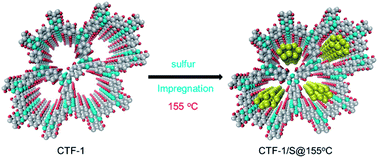Covalent-organic frameworks: potential host materials for sulfur impregnation in lithium–sulfur batteries†
Abstract
Commercial development of lithium–sulfur (Li–S) batteries is severely hindered by their insufficient cyclability, which is due to the loss of soluble lithium polysulfide intermediates generated during the discharge processes. To overcome this problem, considerable efforts have been devoted to designing novel micro- or nano-structured host materials, aiming to trap soluble polysulfide within the network. Herein, we report a new approach to construct a sulfur electrode by impregnating sulfur into the nanopores of covalent-organic frameworks (COFs). Our results clearly demonstrate that by using a 2D COF as a host material, e.g. CTF-1 (CTF: covalent triazine-based framework), the thus-prepared cathode can show a remarkable positive effect on the capacity retention of Li–S batteries. Considering the unique features of COFs, such as highly flexible molecular design and a controllable pore size, this proof-of-principle study provides new opportunities for materials scientists for tailoring cathode materials in Li–S batteries.


 Please wait while we load your content...
Please wait while we load your content...